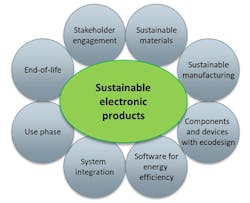How to Build More Sustainable Electronics
Members can download this article in PDF format.
What you’ll learn:
- The necessary criteria when benchmarking the sustainability of electronic products.
- How the GreenTool can help product developers create more sustainable products.
It’s no secret that the electronics industry has significant environmental impacts like e-waste, high energy consumption, and the depletion of critical raw materials (CRMs). In 2019, we began to investigate how the electronics industry could become more sustainable.
Through our work, we devised a sustainability benchmarking tool called the “GreenTool,” which is developed specifically for the electronics sector. It provides an estimate of product sustainability during the product design and development phases to guide the productization process.
The tool also compares different printed electronic concepts with each other from a sustainability perspective, and considers raw materials, manufacturing, use phase, end-of-life management, and sustainability maturity (see figure).
The Purpose Behind the GreenTool
The GreenTool is specifically designed to benchmark novel, more sustainable, solutions against existing state-of-the-art products. Ultimately, the tool is useful for internal product development and eco‐design, and it can even be beneficial for B2B customers looking for new sustainable product alternatives.
In this article, we introduce the GreenTool and show how it works by benchmarking flexible and printed electronics against existing modern solutions. We’ll cover how and why we developed the tool, in addition to how we recommend using it in the future. If you would like to read more detailed examples of its use and see the tool in action, you can find the full academic study here.
The GreenTool’s purpose is to increase awareness of the different aspects of sustainability and support the design of more sustainable electronics. Sustainability initiatives like the EU's Green Deal and Circular Economy Action Plan, as well as the U.N.'s Sustainable Development Goals, push for a circular economy and reduced environmental impact. In the future, integrating more sustainability into products isn’t going to be an option so much as a necessity to keep up with modern legislation, such as the EU Regulation on Ecodesign for Sustainable Products (ESPR).
Our aim is that future electronic product developers will be able to use the tool to best understand how they can design electronics that meet legislative sustainability requirements as a part of the circular economy. We anticipate that the GreenTool could also be extended to other product categories with small modifications.
Developing the GreenTool
The goal of the development phase was to create and implement a qualitative assessment and benchmarking tool for the sustainability of printed electronics. The purpose of the GreenTool was to benchmark flexible and printed electronics solutions under development against state-of-the-art solutions and compare different approaches taken toward sustainable electronics.
To get a broad view, the assessment was carried out for several criteria based on the eco-design directive: raw materials, manufacturing, logistics, installation and maintenance, the use phase, end‐of‐life management, and sustainability maturity. Each criterion is divided into sub-criteria that are the actual data points used for the comparison.
The scoring is presented as a comparison to a baseline, a reference product, or a product option already available in the market. The products under assessment are compared to this baseline per each sub-criterion, either as exceeding or falling under the reference product in the sustainability performance. The GreenTool is thus built on European and global sustainability regulations and recommendations, and it considers environmental, economic, and social sustainability.
Tests to Evaluate the GreenTool
We carried out two experiments to evaluate the performance of the tool: (1) four smart label concepts, and (2) three wearable concepts. In these experiments, printed concepts were benchmarked against an existing electronic product.
The biggest sustainability differences among the product concepts were found in the categories of raw materials and manufacturing in both experiments, as well as logistics criteria in smart label comparison and use phase in wearables comparison. In the other criteria, the differences were smaller, but provided slight improvements in sustainability.
It should be noted that there were also significant differences in end-of-life criteria, but since the suitable methodologies and processes don’t yet exist, comparison here was a highly hypothetical one. To conclude, we consider the GreenTool to be suitable for qualitative sustainability comparisons in product concept design. What follows are the areas where the most sustainability impact was found.
1. Product design plays a crucial role in minimizing environmental impacts
Product design is a critical stage in the lifecycle of a product. Typically, 80% of the environmental impacts are determined during the design phase.
The current ESPR directive sets targets for safe and sustainable designs, which also covers electronic products. Future electronic product design will thus balance cost, performance, and sustainability, and our GreenTool aims to help this process.
During development of the tool, we found that the industry can reduce its environmental burden by shifting to bio-based materials, minimizing the use of critical and harmful metals, adopting efficient manufacturing processes, and developing integrated components. Circular economy business models and extending product lifecycles also offer opportunities for better sustainability. For example, circular design concepts enable component disintegration, material recovery, repairability, and durability.
2. Sustainable manufacturing
Sustainable production in the electronics industry can be achieved by using bio-based, renewable, and abundant materials, as well as shifting to energy- and material-efficient additive-manufacturing methods. Printing-based additive methods offer advantages like smaller dimensions, reduced weight, and less material use.
Additive manufacturing reduces energy consumption and eliminates the use of hazardous chemicals. It also aligns with circular economy goals by utilizing renewable materials and minimizing waste.
3. Renewable, bio‐based, and abundant raw materials
The major environmental impacts of printed electronics are from the fossil‐based substrate materials and metals used. The main bio‐based substrate materials for flexible electronics are currently different biopolymer‐based bioplastics, e.g., polylactic acid (PLA), and cellulose based materials, e.g., paper‐based products.
Printing methods are compatible with these new materials, creating a sustainability opportunity. The introduction of bio-based substrates to etching-based processes is more challenging, since many processes there aren’t compatible with porous or temperature-sensitive substrate materials.
In addition, the electronics sector depends on a variety of CRMs. Critical metals are increasingly used in various components but always in small quantities, making recycling challenging. We suggest substituting CRMs to reduce reliance on these materials, and again printing processes are a sustainability opportunity, since printed electronics are not reliant on CRMs. Silver is the most common metal used in printed electronics, although it has high environmental impact. It could be substituted with printed copper, aluminum, or even carbon, to significantly improve sustainability.
4. Sustainable use of products
This means that products are more sustainable in their use phase, including the product’s lifetime, energy efficiency, and performance. As more products are designed in a way that allows for longer time in use, products with lower weight and smaller footprint, new ways of using products (e.g., home monitoring), and new functionalities (e.g., package monitoring), it can lead to reduction of waste, lower carbon emissions, and even improved personal health.
To increase energy efficiency, for example, we recommend using operating systems that consume less energy and increase operational use time. Embedded and green software, artificial intelligence, deep-learning methods, and low-power computing are some of the key technologies that can be employed.
5. End-of-life phase
E-waste is a rapidly growing waste stream in the EU, and managing end-of-life electronics poses challenges in separating materials for recycling without losing value. Currently, there are no commercially available methods for efficient separation and recovery of new types of electronics, such as those that are printed.
One challenge is how to separate electronic material fractions (e.g., metals), and disintegrate components for circularity from non-traditional substrates (e.g., bio-based materials), and among different types of waste streams (e.g., package or textile waste). This also calls for efficient collection concepts of e-waste from, for example, consumers, that will certainly support means to extend the lifetime of their products, such as repairability and upgradeability.
To overcome this challenge, end-of-life management based on efficient circular economy models is required, including eco-design and circular design concepts, as well as methods for material and component disintegration, also tailored for printed electronics.
Biodegradable electronics are also seen as an opportunity for the management of a growing number of electronic devices. In biodegradation and composting, though, materials are lost from secondary use. Therefore, the applicability and benefits should be verified case by case. However, single-use electronics, such as health patches, might benefit from this end-of-life model.
Next Steps for the Future
The electronics industry faces a transformation at this juncture with the introduction of new design, materials, and manufacturing processes, so the need arises for a sustainability assessment tool tailored for the development phase. Other sustainability tools are out there for product design, but the GreenTool is unique because it's the first of its kind specifically designed for the electronics industry.
The importance of holistic circular design of future solutions is a major theme of our work. It won’t be possible to modify every existing product to match the future regulation, but the development of novel products should consider sustainability.
We acknowledge that certain trade‐offs will be made between recyclability and durability or electrical performance and minimal environmental impact (for example), in the first phase. However, the challenges related to the different tradeoffs can be overcome when materials, manufacturing, and end-of-life management become more mature. We also recommend that lifetime extension is a powerful route to decrease the environmental footprint of a product.
Our main recommendation is that electronic product developers use the tool to better understand and integrate sustainability into the products that they design. In the future, the tool will be able to highlight the different sustainability aspects to developers and provide an overall view of what areas need the most attention. The GreenTool is built on requirements of the legislative framework of the EU to support future efforts and the taxonomy is based on existing policy instruments, so it can be considered a fairly stable benchmarking tool.
References
Hakola, Liisa and Smolander, Maria, “Decreasing environmental footprint with printed electronics,” Proceedings of Going Green CARE INNOVATION 2023, 8th International Symposium and Environmental Exhibition, 2023, Vienna, Austria.
The European Commission, “Sustainable Product Policy.”
Naji Nassajfar M, Välimäki M, Hakola L, Eiroma K, Immonen K, Abdulkareem M, Horttanainen M, “The effect of conductive ink alternation on the sustainability and functioning of printed electronics,” 2023.
“Flex Print Electron,” 8(2):025015.
About the Author
Liisa Hakola
Senior Scientist and Senior Project Manager. VTT Technical Research Centre of Finland
Liisa Hakola (M.Sc. Tech) is a Senior Scientist and a Senior Project Manager at VTT Technical Research Centre of Finland.
Maria Smolander
Senior Research Scientist and Research Team Leader of Flexible Sensors and Devices, VTT Technical Research Centre of Finland
Maria Smolander (Doctor of Technology) is a Senior Research Scientist and Research Team Leader of the flexible sensors and devices at VTT Technical Research Centre of Finland.

